Devils Hole, a Unique Geologic and Ecological Wonder in Death Valley
Devils Hole, a deep, water-filled limestone cavern, stands as one of the most enigmatic and unique features near Death Valley National Park. Located in Nevada, within the Ash Meadows National Wildlife Refuge near the California border, it is a geologic and ecological marvel that has captivated scientists, divers, and nature enthusiasts alike.
This isolated aquifer, approximately 22 meters long and 3.5 meters wide at the surface and fed by deep underground springs, maintains a near-constant temperature of approximately 92 degrees Fahrenheit. This stable thermal environment is critical for its unique ecosystem. The surface opening, resembling a large pond, is the only natural access to this extensive underwater system.
Central to the Devils Hole ecosystem is its most famous inhabitant, the Devils Hole Pupfish (Cyprinodon diabolis), one of the rarest fish species on Earth, found nowhere else. The ecosystem is characterized by its isolated aquatic environment, limited flora and fauna, and unique geological features that contribute to its climatic and hydrological stability. Due to its uniqueness and the endangered status of the pupfish, Devils Hole is a significant site for conservation and scientific research, highlighting the delicate balance between geological wonders and biological survival.
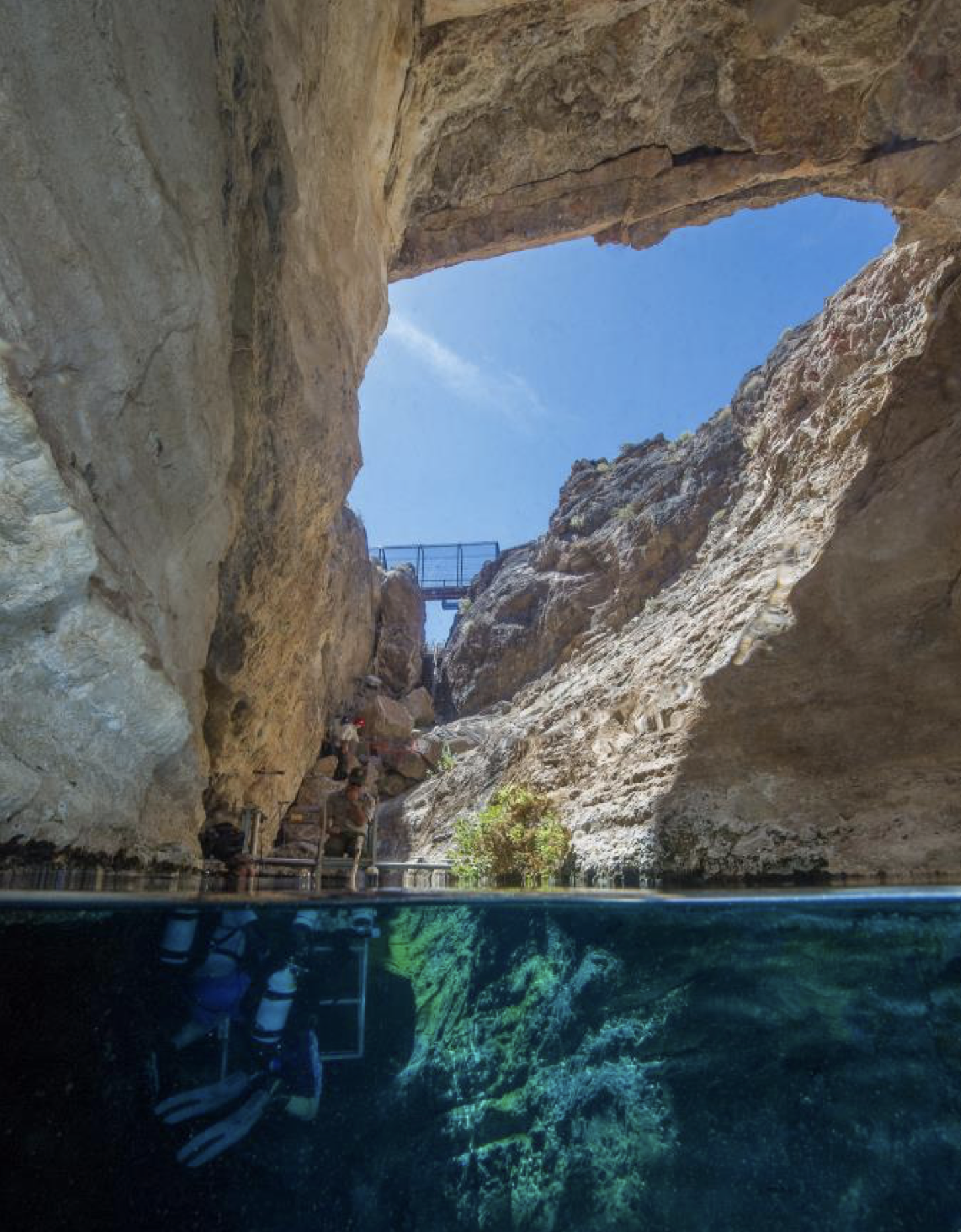
Geological Formation
Devils Hole is a testament to the slow yet powerful forces of nature, having formed over thousands of years through a process known as karstification. This process involves the gradual dissolving of limestone, a soluble rock, by acidic groundwater. The acidic water, often rich in carbon dioxide, percolates through soil and rock layers, slowly eroding the limestone and creating cavities and tunnels. Over millennia, these erosional processes have sculpted Devils Hole into its current form.
The exact depth of Devils Hole is indeed a mystery, with estimates suggesting it extends over 500 feet deep. This depth comprises a complex network of underwater caverns and passageways, many of which remain unexplored and poorly understood. The cavern’s depth and the clarity of its water have made it a site of interest not only for biologists studying the pupfish but also for geologists and speleologists.
The geology of Devils Hole is further complicated by its connection to the regional aquifer system. The water level within the hole fluctuates in response to both distant seismic activity and local changes in the water table, indicating a deep and intricate connection to the surrounding landscape’s hydrogeology. These fluctuations have been observed to affect the pupfish population and their spawning cycles, demonstrating a delicate balance between geological and biological systems.
Moreover, the formation of Devils Hole is closely tied to the broader geological history of the region. The area around Death Valley is known for its dynamic geological past, characterized by extensive volcanic activity and the shifting of tectonic plates. These larger geological processes have played a significant role in shaping the landscape, including the formation of the Amargosa Range and the basin that houses Ash Meadows and Devils Hole.
Devils Hole is not just a unique ecological habitat but also a fascinating geological feature. Its formation through karstification, its mysterious depths with unexplored caverns, and its connection to the regional aquifer system and the area’s geological history, all contribute to its significance as a natural wonder. This complex interplay of geological processes over vast timescales underscores the dynamic nature of Earth’s surface and the ongoing evolution of its landscapes.
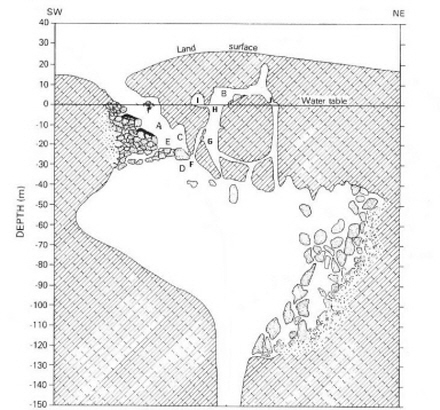
Diving Expeditions and Discoveries
Devils Hole, a unique and enigmatic subaqueous environment, has been the focus of numerous diving expeditions, each contributing to our understanding of this remarkable ecosystem. These expeditions, often led by researchers and highly skilled cave divers, have made significant discoveries about the geology, biology, and hydrology of the site.
Early Explorations
The National Speleological Society conducted some of the first documented dives in the 1950s. Using SCUBA gear, which was relatively new at the time, these pioneering divers were the first to observe the underwater environment of Devils Hole. Their initial surveys laid the groundwork for future explorations and scientific studies.
Photographic Missions and Ecological Studies
ubsequent dives focused on capturing the first images of the underwater landscape and studying the Devils Hole pupfish. These photographic missions provided a visual understanding of the cave system and helped biologists observe pupfish behavior in their natural habitat. The data collected on these missions were crucial in understanding the pupfish’s life cycle, reproductive habits, and ecological needs.
Hydrogeochemical Investigations
In the 1980s, a series of dives were conducted to study the water chemistry and geology of Devils Hole. These dives revealed the complexity of the underwater chambers and the unique hydrogeochemical properties of the water. Scientists collected samples from various depths, which helped in understanding how the water’s chemistry changed with depth and contributed to the unique conditions that support the pupfish.
Mapping the Underwater Chambers
Detailed mapping expeditions have been crucial in understanding the physical layout of Devils Hole. These dives used advanced navigation and mapping techniques to chart the submerged passageways and chambers. The maps produced from these expeditions have been invaluable for scientific research and for planning future exploratory and conservation efforts.
Observing Seismic Impact
One of the most dramatic discoveries came when divers observed the effects of distant earthquakes on the water level and dynamics within Devils Hole. This phenomenon, known as a seiche, caused significant water movement within the cave, impacting the pupfish and their habitat. These observations provided insights into the connection between geological events and the aquatic ecosystem.
Conservation Efforts
Diving expeditions have also played a critical role in conservation efforts. By monitoring the pupfish population and environmental conditions, divers have provided essential data for managing and protecting this endangered species.
Despite these efforts, much of Devils Hole remains a mystery. The hazardous conditions, including narrow passageways, fragile rock formations, and the depth of the cave system, make it a challenging and dangerous environment to explore. The unknown extents of the underwater caverns continue to intrigue and challenge the diving and scientific communities, holding secrets yet to be uncovered about this unique and isolated ecosystem.
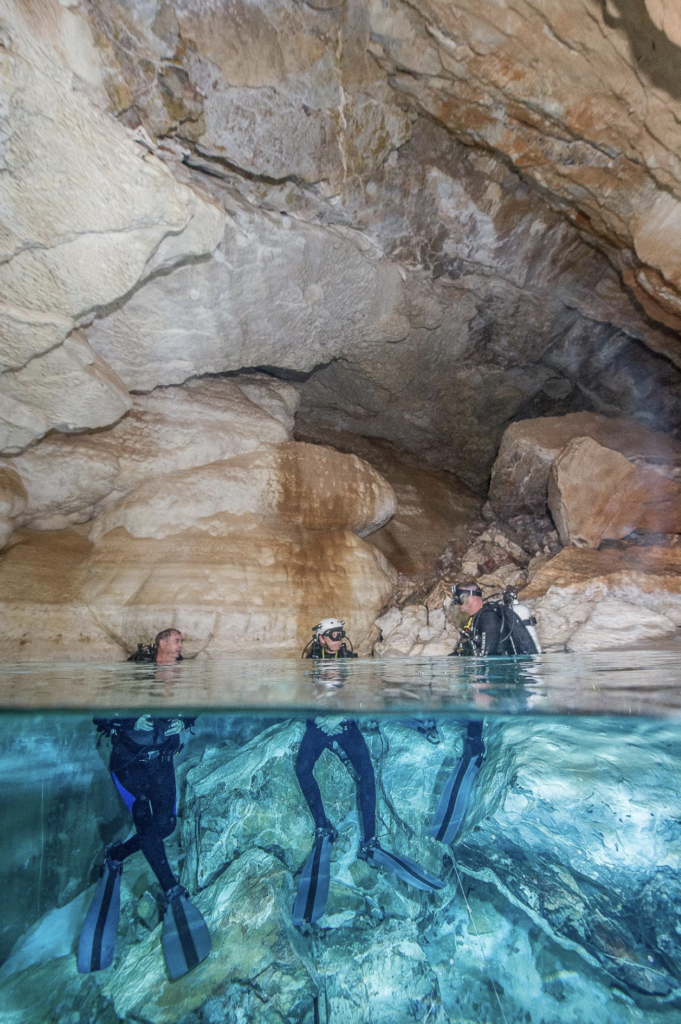
Exploring the Depths of Devils Hole Cave
Near the famed Devils Hole, approximately 650 feet (200 meters) to its north, lies another intriguing subterranean formation known as Devils Hole Cave (#2). This separate cave system was first explored by divers from the Southwestern Speleological Society in February 1961, who adventured into its watery depths down to 70 feet (21 meters). The cave’s structure is unique, resembling the shape of a boot, with a notable constriction caused by fallen rocks at about 50 feet (15 meters) below the surface. The cave leads to a pool of warm water, maintaining a constant temperature of 93 °F (34 °C). A vital feature of this cave is the absence of sunlight in its waters, which prevents algae growth and, consequently, the presence of fish.
Above ground, the cave openings are secured and accessible via a road connecting to Devils Hole, covered by a locked metal grate for protection. Subterranean connections between Devils Hole Cave and Devils Hole itself have been hypothesized, suggesting a deeper, undiscovered waterway link, but this remains a mystery to be unraveled by future explorations.
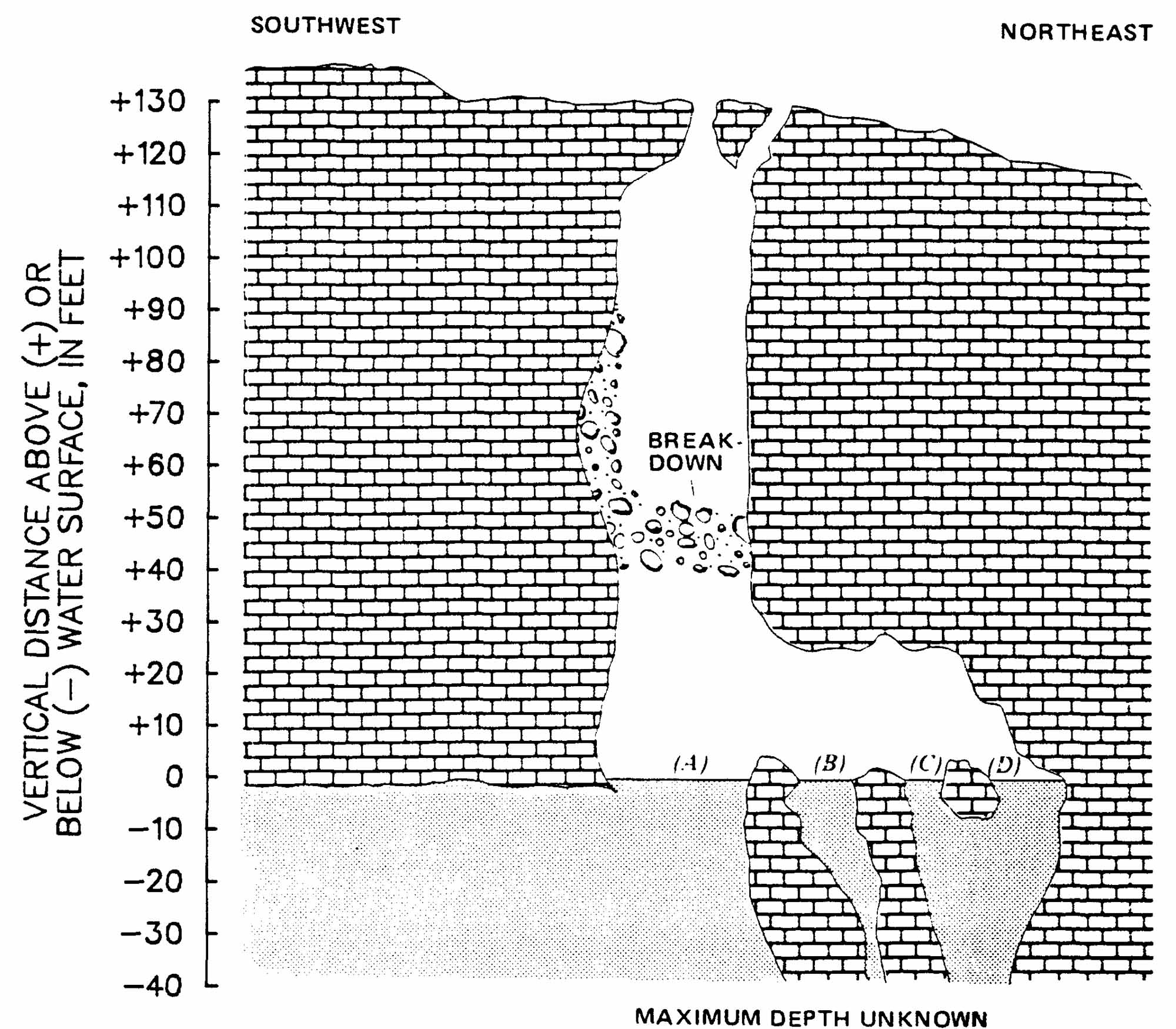
Tsunami Phenomenon in Devils Hole, Death Valley
Devils Hole serves as a remarkable natural gauge for global seismic activity. This subterranean water-filled cavern reacts visibly to large earthquakes, even thousands of miles away. Significant seismic events in distant locations like Japan, Indonesia, and Chile have led to a phenomenon akin to a miniature tsunami within Devils Hole. The force of these distant tremors causes the water within this narrow chasm to oscillate dramatically, similar to water in a bathtub. During such events, waves can surge up to two meters high against the cavern’s walls. The waves not only provide a fascinating natural spectacle but also have ecological implications. The forceful waves play a crucial role in the ecosystem by cleansing the shallow ledges that are critical for the survival of the endangered Devils Hole pupfish, a species unique to this habitat.
Devils Hole Pupfish – One of the Rarest Fish Species on Earth
Ecologically, Devils Hole is the sole habitat of the Devils Hole pupfish (Cyprinodon diabolis), one of the world’s rarest fish species. These tiny, iridescent blue fish are adapted to warm, oxygen-poor waters and have a minimal diet based on algae and microorganisms. Their existence is so closely tied to Devils Hole that water level or quality changes can significantly impact their survival. This species has become a symbol of conservation efforts, highlighting the importance of preserving unique ecosystems.
The pupfish are primarily confined to the top 80 feet of Devils Hole pool, where sunlight permits algae and other food sources to grow. The surface area of this life-sustaining zone is roughly the size of a large living room, an incredibly small space for an entire species to exist. The water temperature is consistently warm, around 33°C (91°F), and the environment is remarkably stable, factors that have likely contributed to the pupfish’s survival in such a restricted habitat.
The Devils Hole Pupfish is a marvel of evolutionary adaptation. They are incredibly hardy, surviving in conditions that would be lethal to most other fish. Their diet consists mainly of algae and microorganisms found in their habitat. Remarkably, the population fluctuates seasonally, usually numbering between 100 to 200 individuals, a count that underscores their vulnerability to extinction. The species has adapted to the limited resources and space of their environment, exhibiting behaviors and physical characteristics distinct from their nearest relatives, other pupfish species found in the region.
Conservation efforts for the Devils Hole Pupfish are intense and multifaceted, reflecting the fish’s precarious status. The site is rigorously protected and monitored by the National Park Service and other conservation agencies. Scientists have worked tirelessly to understand the pupfish’s biology and ecology, efforts that are critical for informed conservation strategies. In recent years, there have been attempts to create refugia or artificial environments that mimic Devils Hole to provide a safety net for the species. These efforts underscore the challenges of conserving a species so finely tuned to a unique and fragile habitat.
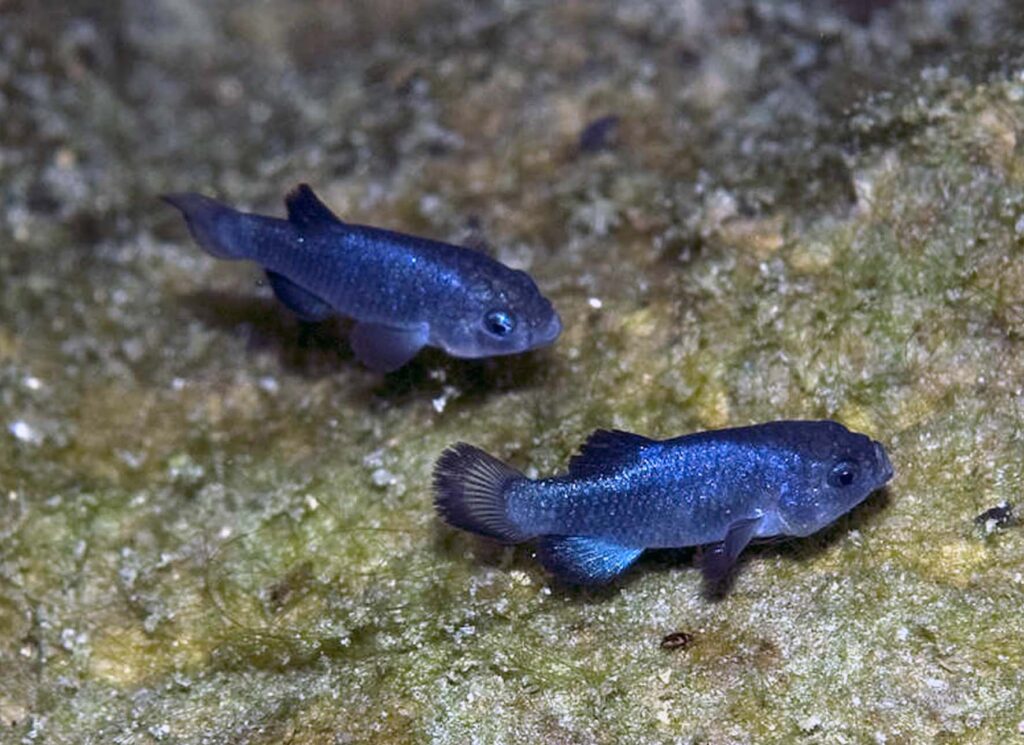
Devils Hole a Natural Ecosystem
The ecosystem is extremely sensitive to external influences due to its isolation and the delicate balance maintained within it. Factors such as climate change, groundwater extraction, and human activity in the surrounding area pose potential threats.
The ecosystem has remained remarkably stable over thousands of years. The constant water temperature and chemistry have allowed the Devils Hole pupfish to survive and adapt to this specific environment. However, this stability also makes the ecosystem vulnerable to changes in water levels and quality.
Due to its uniqueness and the endangered status of the pupfish, Devils Hole is a significant site for conservation and scientific research. It provides insights into the adaptability and limitations of life in extreme and isolated conditions. The site is heavily protected and monitored to ensure the survival of its endemic species.
Devils Hole is not only a geologic wonder but also an ecological treasure. It is an example of natural ecosystems’ unique and often fragile balance. The ongoing research and exploration efforts in Devils Hole help us understand more about underground aquatic systems, karst environments, and species adaptation in extreme conditions. This remarkable site continues to fascinate and challenge those seeking to uncover its mysteries, reminding us of the importance of preserving such unique natural habitats.
The Devils Hole ecosystem is a remarkable natural laboratory, offering a unique window into the resilience and fragility of life in an isolated and extreme environment. Its conservation is crucial, not only for the survival of the Devils Hole pupfish but also for understanding the broader implications of habitat loss and environmental change.
Related Articles
Ash Meadows National Wildlife Refuge Ecosystem
Death Valley Pupfish Count News Article with Photos (April 2022)